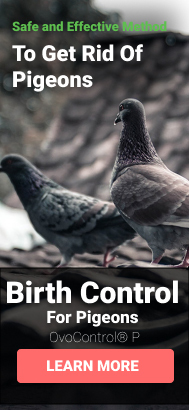Physical Exclusion of Pigeons – Spikes, Wires, Nets and Slides
Written by Erick Wolf
What are the options for physically excluding pigeons and other birds?
A little research on the internet will reveal literally dozens of different options for physically excluding pigeons and other birds from a structure or facility. The idea is to create a barrier or other impediment to physically prevent the bird from entering a defined space.
When people with the problem ask us about “how to get rid of pigeons” and “what’s the most effective method", we usually answer that the utility of the different pigeon control options can range from highly effective to no effect whatsoever depending on the site and circumstances.
Similarly, the costs can range from trivial to excessive. For example, a net to cover a small canopy on a gas station might be just the perfect, cost-effective solution for that site, whereas, the same net to cover the inside of an aircraft hanger might break the bank.
There are small projects and large ones, each with different options, some more effective than others. Again, much is determined by the site and circumstances. The following table provides a summary of the physical exclusion solutions for pigeons,
| Method/Product | Best Used For | Advantages | Disadvantages |
| Physical Exclusion | |||
| Spikes | Rails, perching areas | Inexpensive; can be highly effective under the right set of conditions; easy installation | In best case, will only move birds to the next best location |
| Bird Wire | Rails, fences, rooflines, perching areas | Useful tool to keep pigeons off perching areas. | More complex installation especially on rooflines |
| Slides | Narrow perching areas | Inexpensive and relatively easy installation | Only suitable under the appropriate conditions where a slide can be installed. |
| Netting | Gold standard for physically excluding birds from both large and small areas and structures | Tangible and immediate effect; can represent a permanent fix for problem birds. | Costly installation requiring professionals. Moves the problem to neighboring structures or facilities |
| Shock track systems | Rails, perching and loafing areas and surfaces | Highly effective in keeping birds off landing and perching areas | Equipment can be complex. Professional installation normally required. More costly than spikes |
Are Spikes a Good Option for Excluding Pigeons?
Pigeon Spikes
Spikes are probably the most common and inexpensive option for excluding pigeons. Look around your city and you will find spikes glued to many different structures and facilities. Most often manufactured in strips, they work on the premise that pigeons cannot land on the pointed ends of the spikes.
Spikes are an excellent strategy to keep pigeons off perching areas - narrow surfaces where pigeons like to perch and observe what is going on down below. Take, for example, a narrow rail on a balcony. A spike strip could represent the perfect inexpensive DIY solution to keep pigeons off the rail and your balcony clean.
Spikes come in a variety of shapes and materials - blunt or pointed, stainless steel or plastic, depending on your needs. There is also an abundance of suppliers and choices.
While an excellent choice for keeping the birds off a narrow perching area, spike strips have a serious downside – the birds are simply going to go to the next best rail without a spike strip. If your only interest is the one rail, then fine, you found your solution. If, however, you are responsible for the entire building and have a hundred rails, it might not represent the best solution for you.
In fact, all physical exclusion options have the same downside – the birds are not leaving the area but rather just relocating. For example, take a university campus with hundreds of structures. Spike strips and other forms of physical exclusion may solve the problem at the first structure but simply moves the problem to another location on the campus.
Bird Wire for Excluding Birds
Pigeon Wires
A corollary for spike strips is a bird wire. These wires are installed on perching or landing areas to make them uncomfortable for the birds. Often attached with springs, the system is designed to create an unstable landing area.
There is also the option to install the wire in the form of a coil or even moving wires to make the area uncomfortable or inaccessible for the birds.
Taken to an extreme, a grid wire system can be installed to prevent larger birds, like seagulls from landing on a roof or body of water.
Shock Track Systems for Birds
A technological innovation and alternative to spikes, a shock track overcomes many of the limitations of spike strips. A shock track works on the same principle as an electric fence, providing a small jolt to the feet of the pigeons to make the surface uncomfortable.
The system installs in form of a low-profile electrified track and conforms to many different surfaces and configurations. There are two wires that run through the track. When the pigeon connects the two wires, they get a jolt and learn not to land or stand on the track. The shock does not hurt or harm the birds.
Power for these systems spans all the options – plug in, solar and battery powered.
A major advantage over spike strips is low visibility. Instead of covering a building or ledge with spikes, a shock track is virtually invisible from below and the casual observer.
Nets to Physically Exclude Birds
Pigeon Nets
Nets represent the gold standard to physically exclude birds. It is easy to understand why this technique represents the most effective method for excluding birds from a specific area. When professionally installed, a net creates a physical barrier between the area where the birds are located and the area where they are not wanted. Simple! Unfortunately, while simple to understand, netting may also represent the costliest of all options and is clearly not appropriate for all sites and circumstances.
Nets are commonly used for enclosed or semi-enclosed areas, openings, or configurations in commercial buildings, open beam structures, loading docks, facades, courtyards, bridges, balconies, storefront signs, etc. Materials are typically polyethylene twine and stainless-steel installation hardware attached to a cable system which holds the net in place.
While they can be highly effective, nets may not be the answer to pigeons in larger sites where they quickly become cost prohibitive.
Slides to Exclude Pigeons
Pigeon Slides
Perhaps the most direct and least costly technique to keep pigeons off a ledge is a plastic “slide”. What a slide does is change a flat surface to one with a 45-degree angle. A pigeon cannot land on a 45-degree angle and quickly finds another place to go. The “slide” can be extended up to 16” to accommodate many different designs and structures. Made of plastic, this exclusion method is typically installed on interior surfaces.
Again, like all other exclusion techniques, ultimately a slide will simply move the bird to another convenient location in your structure. If that is all you need, physical exclusion could be the answer to your pigeon problems. If you need more than what is described here, you may need to consider abatement strategies (such as pigeon birth control) to reduce the bird numbers to an acceptable level.
Learn more about pigeon control alternatives:
- Pigeon Culling Methods: Poisoning, Shooting, Traps and Raptors
- Reducing Pigeon Reproduction: A Long-Term Solution for Pigeon Control
- Physical Exclusion of Pigeons – Spikes, Wires, Nets and Slides
- Pigeon Deterrents - Effigies, Sonic Emitters, Propane cannon
- Bird Netting: Everything you Should Know








